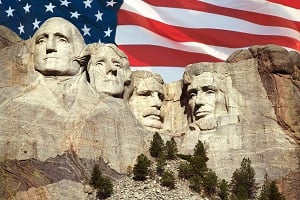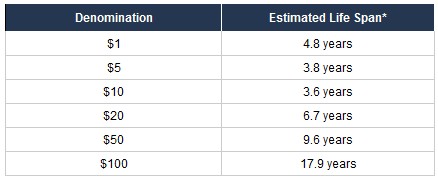 In honor of President's Day, we're taking a look at presidential leadership and their correlation to U.S. currency. In other words, do you know whose face is on the $50 bill? I'll give you a hint, it's none of these guys to the left.
In honor of President's Day, we're taking a look at presidential leadership and their correlation to U.S. currency. In other words, do you know whose face is on the $50 bill? I'll give you a hint, it's none of these guys to the left.
Consumer checks and credit cards can be customized with different backgrounds, personal photos and the like. However, one of the unique features of coin and paper currency is that many denominations portray a United States President. Where else will we see our presidents on an everyday basis? Sure, Mount Rushmore is spectacular but we don't interact with it every day like we do cash and coins.
Many of us can rattle off which president is on the $1 bill or the penny, but who is on the $20 bill or the dime, for example? Stumped? It's Presidents Andrew Jackson and Franklin Delano Roosevelt, respectively. Oh, and the answer to my question at the outset, is President Ulysses S. Grant. To see more, here's a complete listing of all presidents that can be found on United States currency.
Some interesting facts about United States currency:
- Presidents are not the only members featured, Alexander Hamilton is on the $10 bill and Benjamin Franklin is on the $100 bill
- Only deceased historical figures are represented, which is one reason why Presidents Carter, Bush and Clinton are not featured
- No African Americans have ever appeared on paper currency. Will that change in time with President Barack Obama?
- Since 1969, the largest bill in circulation has been the $100 bill
- The largest bill ever printed is a $100,000 Gold Certificate, but it was only used between Federal Reserve branches - not for public circulation
Increasing anti-counterfeiting measures have been added over the years, but presidents have been a mainstay. Congress chooses which presidents and historical figures will appear on United States currency, with advisement from the Secretary of the Treasury, but the Bureau of Engraving and Printing does the actual printing. Why are presidents on currency in the first place? It's a way of recognizing their respective service to our country.
With paper and coin remaining a dominant payment method, the life expectancy can vary. Generally the smaller the bill's denomination, the shorter the life span because the more they get handled by the public. But that is not always the case as this chart by the Federal Reserve shows:
Over time United States Presidents have helped establish the foundations of this country. It only makes sense that we honor them by putting their portrait on our currency as a constant reminder. We might be in the check payments business, but we can't ignore the significance that cash and coins present. Even with electronic payment methods becoming popular, cash is not going away any time soon.
There have been many iterations of United States currency, but presidential leadership has been constant for the most part. Currency can be collector's items of sorts - state quarters come to mind. How many of you have a collection of $2 bills simply for the fact they are rare? I know I do.
Do you have any facts about President's Day or currency you would like to share?



